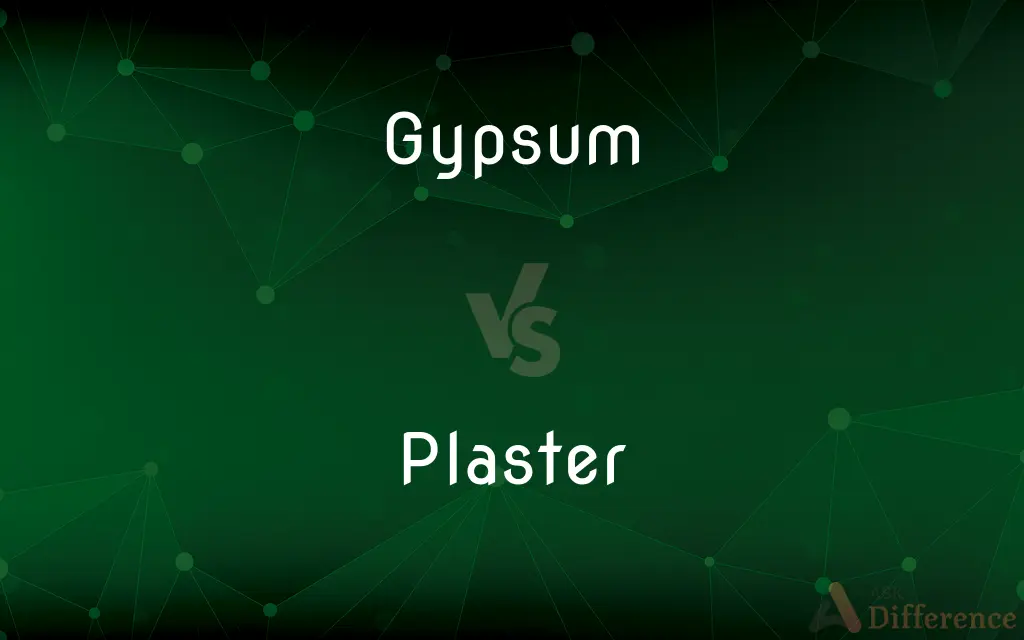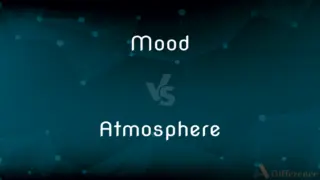Gypsum vs. Plaster — What's the Difference?
By Urooj Arif & Fiza Rafique — Updated on March 28, 2024
Gypsum is a naturally occurring mineral used in the production of plaster and other building materials, while plaster, often made from gypsum, is a building material applied in paste form that hardens over time.

Difference Between Gypsum and Plaster
Table of Contents
ADVERTISEMENT
Key Differences
Gypsum is a soft sulfate mineral composed of calcium sulfate dihydrate. It is mined from the earth and used in various industries, notably for making plaster of Paris, drywall, and other construction materials. Plaster, on the other hand, can be made from gypsum by heating the mineral to remove water, forming a powder that, when mixed with water, becomes a malleable paste. This paste can be applied to walls, ceilings, or other surfaces and hardens as it dries.
While gypsum acts as a raw material, plaster is the product used for construction and artistic applications. Gypsum’s role is primarily as a source material, whereas plaster's role is functional and aesthetic in buildings and sculptures.
The process of creating plaster from gypsum involves heating the gypsum at a moderate temperature to remove approximately three-quarters of the water content. This process, called calcination, results in a fine powder called plaster of Paris. When water is added to this powder, it rehydrates and can be molded or spread before it sets hard.
Gypsum is valued for its ability to regulate humidity by absorbing and releasing water vapor, contributing to healthier indoor air quality. Plaster, particularly when made from gypsum, retains this property, making it a preferred material for interior walls and ceilings.
Both materials are integral to the construction industry, but their roles are distinct. Gypsum is the core component, while plaster is the versatile material that builders and artists use to create smooth, durable finishes on various surfaces.
ADVERTISEMENT
Comparison Chart
Composition
Calcium sulfate dihydrate
Can be composed of gypsum, lime, or cement
Form
Raw mineral
Mixture applied in paste form and hardens over time
Use
Raw material for producing plaster and other products
Construction and artistic material for coatings and moldings
Properties
Regulates humidity, fire-resistant
Durable, can regulate humidity, provides smooth finish
Process
Mined and processed into various products, including plaster
Made by mixing powder with water and applying it to surfaces
Compare with Definitions
Gypsum
Raw material.
It serves as a crucial ingredient in the manufacture of plaster and drywall.
Plaster
Building material.
Plaster is applied to walls and ceilings for a smooth finish or for decorative moldings.
Gypsum
Fire resistance.
Gypsum's inherent fire resistance makes it a safe choice for building materials.
Plaster
Made from gypsum.
Plaster of Paris is created by heating gypsum to form a fine powder.
Gypsum
Natural mineral.
Gypsum is mined from natural deposits, formed from the evaporation of sea water.
Plaster
Hardens over time.
Once mixed with water and applied, plaster hardens to a durable surface.
Gypsum
Versatile applications.
Beyond plaster, gypsum is used in agriculture and food industries as a soil conditioner and food additive.
Plaster
Artistic use.
Artists use plaster for sculptures and decorative elements due to its malleability.
Gypsum
Humidity regulation.
Gypsum boards are used in construction for their ability to balance indoor humidity.
Plaster
Finish and decoration.
Plaster finishes are prized for their aesthetic appeal and surface durability.
Gypsum
Gypsum is a soft sulfate mineral composed of calcium sulfate dihydrate, with the chemical formula CaSO4·2H2O. It is widely mined and is used as a fertilizer and as the main constituent in many forms of plaster, blackboard/sidewalk chalk, and drywall. A massive fine-grained white or lightly tinted variety of gypsum, called alabaster, has been used for sculpture by many cultures including Ancient Egypt, Mesopotamia, Ancient Rome, the Byzantine Empire, and the Nottingham alabasters of Medieval England.
Plaster
Plaster is a building material used for the protective or decorative coating of walls and ceilings and for moulding and casting decorative elements. In English, "plaster" usually means a material used for the interiors of buildings, while "render" commonly refers to external applications.
Gypsum
A widespread colorless, white, or yellowish mineral, CaSO4·2H2O, used in the manufacture of plaster of Paris, various plaster products, and fertilizers.
Plaster
A mixture of lime or gypsum, sand, and water, sometimes with fiber added, that hardens to a smooth solid and is used for coating walls and ceilings.
Gypsum
A mineral consisting of hydrated calcium sulphate. When calcinated, it forms plaster of Paris.
Plaster
Plaster of Paris.
Gypsum
A mineral consisting of the hydrous sulphate of lime (calcium). When calcined, it forms plaster of Paris. Selenite is a transparent, crystalline variety; alabaster, a fine, white, massive variety.
Plaster
A pastelike mixture applied to a part of the body for healing or cosmetic purposes.
Gypsum
A common white or colorless mineral (hydrated calcium sulphate) used to make cements and plasters (especially plaster of Paris)
Plaster
Chiefly British An adhesive bandage.
Plaster
To cover, coat, or repair with plaster.
Plaster
To cover or hide with or as if with a coat of plaster
Plastered over our differences.
Plaster
To apply a plaster to
Plaster an aching muscle.
Plaster
To cover conspicuously, as with things pasted on; overspread
Plaster the walls with advertising.
Plaster
To affix conspicuously, usually with a paste
Plaster notices on all the doors.
Plaster
To make smooth by applying a sticky substance
Plaster one's hair with pomade.
Plaster
To make adhere to another surface
"His hair was plastered to his forehead" (William Golding).
Plaster
To inflict heavy damage or injury on.
Plaster
To defeat decisively.
Plaster
To apply plaster.
Plaster
(uncountable) A paste applied to the skin for healing or cosmetic purposes.
Plaster
A small adhesive bandage to cover a minor wound; a sticking plaster.
Plaster
(uncountable) A mixture of lime or gypsum, sand, and water, sometimes with the addition of fibres, that hardens to a smooth solid and is used for coating walls and ceilings; render, stucco.
Plaster
(countable) A cast made of plaster of Paris and gauze; a plaster cast.
Plaster
(uncountable) plaster of Paris.
Plaster
(transitive) To cover or coat something with plaster; to render.
To plaster a wall
Plaster
(transitive) To apply a plaster to.
To plaster a wound
Plaster
(transitive) To smear with some viscous or liquid substance.
Her face was plastered with mud.
Plaster
(transitive) To hide or cover up, as if with plaster; to cover thickly.
The radio station plastered the buses and trains with its advertisement.
Plaster
To bombard heavily or overwhelmingly; to overwhelm with (weapons) fire.
Plaster
To smooth over.
Plaster
An external application of a consistency harder than ointment, prepared for use by spreading it on linen, leather, silk, or other material. It is adhesive at the ordinary temperature of the body, and is used, according to its composition, to produce a medicinal effect, to bind parts together, etc.; as, a porous plaster; sticking plaster.
Plaster
A composition of lime, water, and sand, with or without hair as a bond, for coating walls, ceilings, and partitions of houses. See Mortar.
Plaster
Calcined gypsum, or plaster of Paris, especially when ground, as used for making ornaments, figures, moldings, etc.; or calcined gypsum used as a fertilizer.
Plaster
To cover with a plaster, as a wound or sore.
Plaster
To overlay or cover with plaster, as the ceilings and walls of a house.
Plaster
Fig.: To smooth over; to cover or conceal the defects of; to hide, as with a covering of plaster.
Plaster
A mixture of lime or gypsum with sand and water; hardens into a smooth solid; used to cover walls and ceilings
Plaster
Any of several gypsum cements; a white powder (a form of calcium sulphate) that forms a paste when mixed with water and hardens into a solid; used in making molds and sculptures and casts for broken limbs
Plaster
A medical dressing consisting of a soft heated mass of meal or clay that is spread on a cloth and applied to the skin to treat inflamed areas or improve circulation etc.
Plaster
A hardened surface of plaster (as on a wall or ceiling);
There were cracks in the plaster
Plaster
Adhesive tape used in dressing wounds
Plaster
Cover conspicuously, as by pasting something on;
The demonstrators plastered the hallways with posters
Plaster
Affix conspicuously;
She plastered warnings all over the wall
Plaster
Apply a plaster cast to;
Plaster the broken arm
Plaster
Apply a heavy coat to
Plaster
Coat with plaster;
Daub the wall
Plaster
Dress by covering with a therapeutic substance
Common Curiosities
Can plaster be made without gypsum?
Yes, plaster can also be made from lime or cement, each with different properties and uses.
Why is gypsum preferred in indoor construction?
Gypsum is preferred for its ability to regulate indoor humidity and its fire-resistant properties, contributing to healthier and safer indoor environments.
How is plaster made from gypsum?
Plaster is made by heating gypsum to remove part of its water content, forming plaster of Paris, which becomes a paste when mixed with water and hardens over time.
What are the benefits of plaster finishes?
Plaster finishes provide a smooth, durable surface that can be decorative. They are also capable of regulating humidity when made from gypsum.
Can plaster of Paris be reused once it hardens?
Once hardened, plaster of Paris cannot be re-melted, but it can be crushed and recycled in some applications.
What is gypsum used for?
Gypsum is used as a raw material to produce plaster, drywall, and other building materials, and as a soil conditioner in agriculture.
What are the differences in properties between gypsum-based and cement-based plasters?
Gypsum-based plasters are lighter, easier to work with, and have better insulation properties, while cement-based plasters are more moisture-resistant and suitable for exterior use.
Is gypsum environmentally friendly?
Gypsum is considered environmentally friendly due to its natural occurrence, recyclability, and use in improving soil condition, though mining and processing impacts should be managed.
How does the fire resistance of gypsum benefit construction?
Gypsum's fire resistance adds an extra layer of safety to buildings, slowing the spread of fire.
What makes plaster ideal for artistic uses?
Its malleability when wet and durability when dry make plaster ideal for sculptures and decorative moldings.
Can plaster be applied over old surfaces?
Yes, plaster can be applied over existing surfaces, but preparation such as cleaning and sometimes applying a bonding agent is necessary.
How does the humidity regulation property of gypsum and plaster work?
Gypsum and plaster can absorb excess moisture from the air and release it when the air is dry, helping to maintain a balanced indoor humidity level.
Are there health concerns associated with gypsum or plaster?
Generally safe, gypsum and plaster can pose dust inhalation risks during mixing or sanding, so protective measures are recommended.
How long does plaster take to dry?
The drying time for plaster varies based on thickness, temperature, and humidity, typically taking a few days to fully set.
How is the environmental impact of gypsum mining addressed?
The environmental impact is managed through restoration projects, recycling of gypsum products, and by adhering to regulations that minimize environmental damage.
Share Your Discovery

Previous Comparison
Mood vs. Atmosphere
Next Comparison
Genuine vs. AuthenticAuthor Spotlight
Written by
Urooj ArifUrooj is a skilled content writer at Ask Difference, known for her exceptional ability to simplify complex topics into engaging and informative content. With a passion for research and a flair for clear, concise writing, she consistently delivers articles that resonate with our diverse audience.
Co-written by
Fiza RafiqueFiza Rafique is a skilled content writer at AskDifference.com, where she meticulously refines and enhances written pieces. Drawing from her vast editorial expertise, Fiza ensures clarity, accuracy, and precision in every article. Passionate about language, she continually seeks to elevate the quality of content for readers worldwide.














































